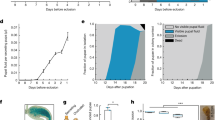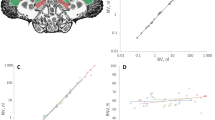Abstract
IN the blood-sucking bug, Rhodnius prolixus, moulting occurs at a definite interval after feeding ; only one meal being necessary in each stage. The morphological changes at moulting are relatively slight ; save at the fifth moult, when the insect becomes adult1. It is therefore convenient (without prejudice to questions of homology) to refer to this final moult as ‘metamorphosis’. In this last stage, the interval between feeding and moulting averages twenty-eight days. If its head is removed soon after feeding, the insect will not moult—although some of these headless individuals have remained alive more than eleven months. But there is a critical period, about seven days after feeding, after which moulting is no longer prevented by decapitation. If the blood from an insect decapitated after this critical period is allowed to circulate in an insect decapitated before this period, the latter is caused to moult. Clearly, a moulting hormone is present ; and it is probably secreted in the head. Of the organs in the head, the only one which shows distinct changes during this period is the corpus allatum, the cells of which swell up to a maximum at about the seventh day after feeding, and then diminish. Perhaps this is the source of the moulting hormone—though the evidence on this point is still incomplete.
This is a preview of subscription content, access via your institution
Access options
Subscribe to this journal
Receive 51 print issues and online access
$199.00 per year
only $3.90 per issue
Buy this article
- Purchase on Springer Link
- Instant access to full article PDF
Prices may be subject to local taxes which are calculated during checkout
Similar content being viewed by others
References
Wigglesworth, V. B., Quart. J. Micr. Sci., 76, 270; 1933.
Kope, S., Biol. Bull., 42, 322; 1922. 46, 1; 1924. Biol. Generalis, 3, 375; 1927.
Author information
Authors and Affiliations
Rights and permissions
About this article
Cite this article
WIGGLESWORTH, V. Factors Controlling Moulting and ‘Metamorphosis’ in an Insect. Nature 133, 725–726 (1934). https://doi.org/10.1038/133725b0
Issue Date:
DOI: https://doi.org/10.1038/133725b0
This article is cited by
-
De novo assembly of the olive fruit fly (Bactrocera oleae) genome with linked-reads and long-read technologies minimizes gaps and provides exceptional Y chromosome assembly
BMC Genomics (2020)
-
Zanthoxylum caribaeum (Rutaceae) essential oil: chemical investigation and biological effects on Rhodnius prolixus nymph
Parasitology Research (2014)
-
Die physiologische Bedeutung der Versondr�sen, untersucht im Zusammenhang mit ihrem feineren Bau
Wilhelm Roux' Archiv f�r Entwicklungsmechanik der Organismen (1935)
Comments
By submitting a comment you agree to abide by our Terms and Community Guidelines. If you find something abusive or that does not comply with our terms or guidelines please flag it as inappropriate.



